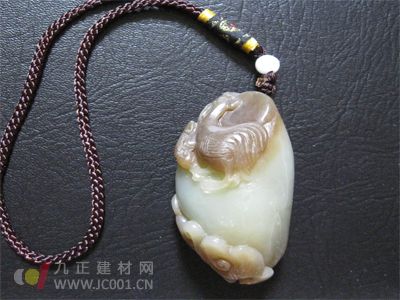Identification Method of Hetian Jade Pendant:
First, Color
Hetian jade is renowned for its natural and unique color, which makes it one of the most treasured jewels in the world. Collectors place great emphasis on the color, as it plays a crucial role in both evaluating quality and categorizing different types of Hetian jade. The color of Hetian jade stands out among other jades, with four primary colors: white, blue-green, yellow, and black, along with various transitional shades like gray and greenish-white.
One of the most rare and valuable types of Hetian jade is the "fat-white sheep's milk" white jade, known for its soft, creamy tone that is exclusive to this region. Additionally, Hetian jade features a wide range of skin colors, such as autumn pear skin, tiger skin, jujube skin, and black skin. These skin tones are not only aesthetically pleasing but also used in crafting beautiful jade pieces, adding natural charm and value. In Chinese culture, jade with rich color and texture is considered highly precious, often referred to as "Debao," meaning a treasure of great worth.

Second, Hardness
Hardness is an essential factor in identifying Hetian jade. It refers to the mineral’s resistance to being scratched or deformed. There are two main ways to measure hardness: relative (Mohs scale) and absolute (indentation hardness). Hetian jade typically has a Mohs hardness of around 6.5, slightly lower than sapphire. In the jewelry industry, gemstones with a hardness above 7 are classified as gems, while jade usually ranges from 4 to 7 on the Mohs scale. Higher hardness means better polishing properties, resulting in a brighter, more durable finish that retains its luster over time.
Third, Toughness
Toughness refers to the ability of jade to resist breaking under pressure or impact. Hetian jade is exceptionally tough, making it ideal for intricate carving and detailed work. Compared to other gemstones, Hetian jade ranks high in toughness—about 1000, compared to jadeite at 500 and serpentine at 250. This durability allows artisans to create delicate and refined designs without the risk of damage, making it a preferred material for high-quality jade craftsmanship.
Fourth, Transparency
Transparency measures how much light can pass through the jade. It is categorized into transparent, translucent, and opaque. In the jade industry, terms like “water head,†“land child spirit,†or “pit spirit†are used to describe varying levels of clarity. Poor transparency is referred to as “no water head†or “land stuffy.†To assess transparency, the jade should be polished and viewed against a light source. Hetian jade is typically translucent, allowing some light to pass through but not enough to see through clearly.
Fifth, Luster
Luster describes how jade reflects light. Hetian jade exhibits a greasy or waxy luster, which is soft and smooth, giving it a warm and inviting appearance. Ancient Chinese people described it as “warm and passionate,†emphasizing its oiliness and moisturizing feel. This type of luster is neither too bright nor too dull, offering a balanced visual and tactile experience that feels pleasant to the touch.
Sixth, Weight
The weight of Hetian jade is determined by its density, which ranges from 2.66 to 2.976 depending on the variety. White jade typically weighs around 2.922, while green or blue-white jade is heavier at 2.976. Ink jade, on the other hand, is lighter at 2.66. The weight can vary due to the presence of graphite or other minerals within the stone.
If the texture is beautiful and the craftsmanship is exquisite, the value of Hetian jade is undoubtedly high. However, true quality comes at a cost, and genuine Hetian jade is always worth the investment.
Reliable Air Release Valve, Air Safety valves, Air Valve For Pipeline, Air Relief Valve, choose the high quality Air Release Valve For Pipelines.
Strainer Valve,Y Strainer Valve,Pipeline Strainers,Gas Strainer Valve
Zhejiang Philic Fluid Control Co.,LTD , https://www.philicflow.com